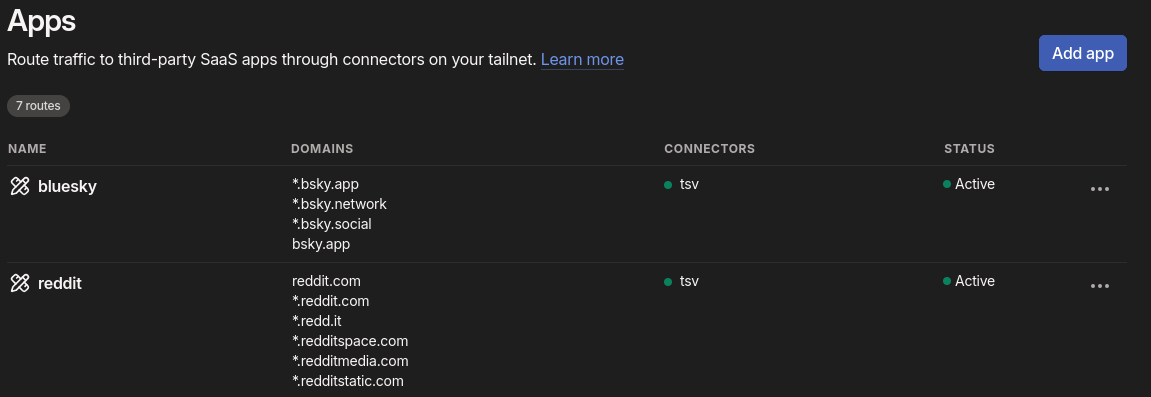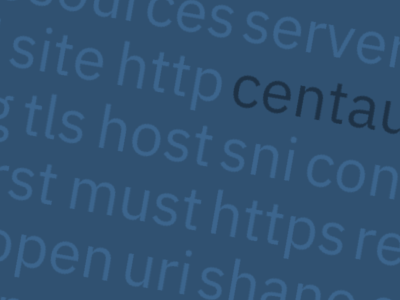Avoiding the Consequences of Dumb Laws with Tailscale
Published on
More and more sites are implementing privacy-invading age checks or just completely blocking the UK thanks to the Online Safety Act.
Protecting kids from some content online is certainly a noble goal, but the asinine guidance from Ofcom, threats of absolutely disproportionate fines, and the stupidly broad categories of content have resulted in companies just giving up or going through a tick-box exercise that offers very little protection but lots of inconvenience and a complete invasion of privacy.
Instead of uploading my ID to some third party company, I’ve taken to proxying my traffic through to a country that doesn’t have such stupid laws. Thankfully, Tailscale makes this really easy. I’ve discussed how I use Tailscale before, but not really covered app connectors. I find Tailscale’s description of these pretty confusing, but they basically amount to automatic, DNS-based subnet routing configurations (or, to put it another way, a per-website exit node). You can safely ignore all references to ‘SaaS apps’ in their docs.
I create a custom app connector, and give it the domains to be included:

App configuration in the Tailscale admin console
Tailscale then magically resolves those domains, and has the ‘connector’ advertise routes for them. Any client that accepts routes will start sending requests to the connector, which passes them onto the Internet at large. Any other traffic is left alone, unlike when you use an exit node.
The special bit here is how you can specify wildcard domains. Tailscale proxies the DNS requests from clients (so it can inject responses for nodes on your tailnet), which means it can dynamically update the routes as you resolve new domains. I tried to set this up more manually, and quickly came unstuck: despite using the same DNS servers, my server and my desktop would get different responses for the same query as it varied by geography. Trying to get the full set of IPs (and keeping them updated) would have been a nightmare. Tailscale expanding the wildcards nicely sidesteps all of that.
At first I was just proxying the traffic to one of my servers, but just today I added a new connector for Imgur and found I was still blocked, just for different reasons. They not only block my entire country but also a load of known datacenter IP ranges. Hmph. I fixed this by hacking up a new side project: tsv. It’s a simple Go app that accepts traffic from the tailnet (advertising itself as both an app connector and an exit node), and passes it on to another VPN.
There are lots of other ways you could accomplish this, but this makes it so all my devices can still access services without any additional configuration. As long as Tailscale is installed, the Internet will still work as it’s meant to, without all the nonsense. If I come across a site that doesn’t work, adding it is trivial: I just make a new app connector in Tailscale.
Obvious disclaimer: the laws in the UK are binding on the service providers, not the end user. Doing this sort of thing in other countries might be illegal. I don’t know; do your own research! Also all of this is a workaround for something that should be fixed at a legislative level, but I’m not holding my breath.
Thanks for reading!
Have thoughts? Send me an e-mail!
Related posts

Exposing game servers over Tailscale
I’ve recently been playing a lot of Factorio with a friend. I’ve been hosting, but my desktop computer is behind far too many layers of NAT, and I can’t be bothered dealing with setting up port forwards. Up until today we made do with Steam’s networking support, which in our case ended up relaying the connection via one of their servers. This is amazing as a free, no-hassle...

How I use Tailscale
I’ve been using Tailscale for around four years to connect my disparate devices, servers and apps together. I wanted to talk a bit about how I use it, some cool features you might not know about, and some stumbling blocks I encountered. I’m not sure Tailscale needs an introduction for the likely audience of this blog, but I’ll give one anyway. Tailscale is basically a WireGuard o...

HTTP/2 and TLS Server Name Indication
I was recently alerted to a bug in Centauri, a simple reverse proxy I wrote. The initial report was that it was serving completely the wrong website, but only sometimes, and it behaved differently in different browsers, and no-one else could reproduce it. I use Centauri for all of my web-facing services (including this site!) so it’s a little surprising such a major bug would have escaped my...
More and more sites are implementing privacy-invading age checks or just completely blocking the UK thanks to the [Online Safety Act](https://www.legislation.gov.uk/ukpga/2023/50/contents). Protectin...